#common blue morpho
Explore tagged Tumblr posts
Text
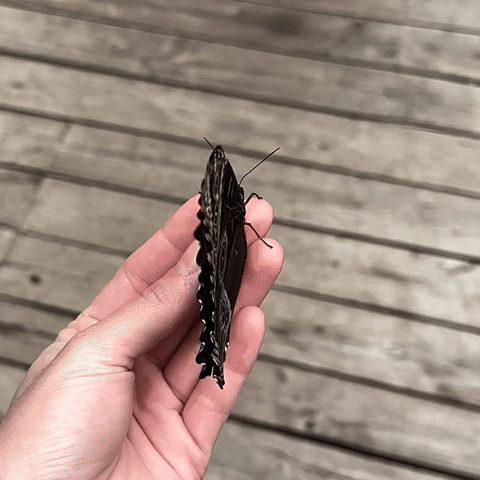
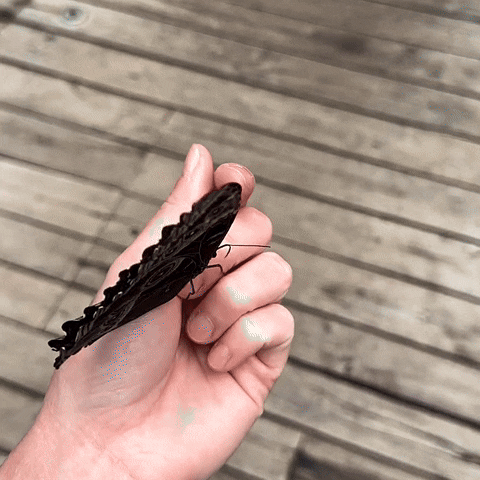
common blue morpho (morpho peleides) | diana_murguta on ig
#stim#butterflies#insects#bugs#sfw#blue#black#white#brown#common blue morpho#morpho peleides#wings#animals#shiny#iridescent#hands#ishy gifs#postish
900 notes
·
View notes
Text

7 notes
·
View notes
Text
tropical gnomes have butterfly farms for clothing and jewelry
#[quickly googles something] .... but maybe not food. can you breed toxicity out of blue morphos and still have them look Like That#of course arachnosericulture is a well established craft and trade amongst gnomes in all biomes as previously established#glaziery is also very common amongst gnomes-- a lot of butterfly wings are mounted to pieces of glass for iridescent beads and bangles#these kinds of things are especially popular in communities with less access to gemstones for whatever reasons#I'm also picturing like. a silk-lined cape that's just layers of shimmering glinting butterfly wings for the exterior#but garments that delicate would HAVE to be exclusive to haute couture and/or some kind of ceremonial use#gnome stuff#worldbuilding
2 notes
·
View notes
Text



Peleides blue morpho
1 note
·
View note
Text
Morpho Helenor or common blue morpho
74 notes
·
View notes
Note
Since you love butterflies I hope you don't mind me sending you a picture of a butterfly that I took last summer! It's a Common Blue Morpho. <3

YES YES YES!!!
I never mind butterfly pics. ❤️ What beautiful butterfly! The way the right wing reflects in the sun is so beautiful. c:
17 notes
·
View notes
Note
sharing some of my pinned morpho butters with you hope that's cool 🥺👉👈 i got so excited to see your new framed one, it's absolutely gorgeous!







Oh these are all radiant! The blue shine is always so mesmerising to look at to me.
I'm guessing Rehtenor, Sulkowsky, Common Blue/Helanor and then Theseus? I would happily sell my soul for that Sulkowsky, it's such a pretty specimen!!
#thank you so much for showing!! these are so so pretty#I swear I can never find sellers who sell them separately? It's always in a big bundle which is wayyy to expensive for me lol#crossing my fingers to find some soon (after I've saved up again lmao)#mel's asks#butterflies
7 notes
·
View notes
Text



Morpho Helenor
My mom took a picture of a common blue morpho butterfly. Morpho helenor is a species of ditrisian lepidopteran of the genus Morpho, family Nymphalidae. It inhabits jungle regions of Central and South America. This species was originally described in 1776 by the Dutch entomologist Pieter Cramer.
The subspecies are very variable in color pattern. Dorsally it is generally black, near the outer edges of the wings show a series of ocelli, white on the forewings, and red on the hindwings. On the anterior edge of the forewings there is a prominent white spot, and in the entire inner area of the wings there is a large blue-blue spot in sharp contrast.
Ventrally it presents a general brownish coloration. It shows white and cinnamon bands on the outer margin of the wings shows a series of dark ocelli, surrounded by a cinnamon halo. From the anterior edge of the forewings there is a prominent white spot that is diluted until it reaches the vicinity of the tail. It shows an irregular chain of large ocelli of different sizes, composed of concentric white, cinnamon, black aureoles, and already in the center with a small white or lilac spot. The outer edge of the hind wings has a prominent series of red spots.
7 notes
·
View notes
Note
hi aly!! happy pride month!
i’ve seen you post about butterflies a few times and i was wondering- which species/type is your favorite?
(also i was totally inspired by your pfp frame so i did one for mine lol)
HI RAINE! :D happy pride month! your pfp looks great!!! :)
AND THANK YOU FOR ASKING ABOUT MY FAVORITE BUTTERFLY!!! i know you probably wanted a singular answer as to which one is my favorite, but i am insane af when it comes to these beautiful lil creatures so i fear i cannot choose 😭 i love them all too much! 🫶 but here is an quick summary of my top ten favorites:

here is a spicebush swallowtail, or Papilio troilus! it is commonly found in north america, it loves deciduous woods and swamps, and i’ll bet you can guess what this pretty lil butterfly’s most common host plant is! (if you guessed a spicebush, you would be correct! 🫶)

this small guy is a chalkhill blue, or a Lysandra coridon! they are found in the palearctic, they love chalky grasslands, and the female chalkhill blues are actually brown rather than blue! :)

this is a red-spotted purple, or Limenitis arthemis! they are spread all throughout north america, they like birches and willow trees, and their scientific name translates to “harbor goddess” in greek! <3

here is a mourning cloak, or the Nymphalis antiopa. this butterfly is native to eurasia and north america. it is montana’s state butterfly, it has one of the longest lifespans of any butterfly (it can live up to a year!), and it is called the camberwell beauty in england!

this is a polyura jupiter! it is found in indonesia and other islands that surround it! the larvae supposedly feed on albizia stipulata! :D
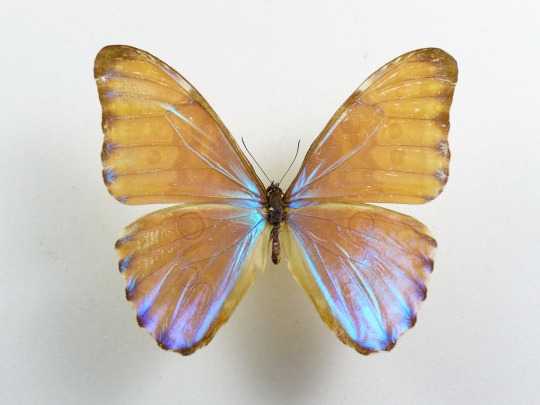
this is a Morpho aurora! it is neotropical, it is found often in the rainforests of peru and bolivia, and it is named after the roman goddess of dawn, aurora!

this is the blue mormon, or Papilio polymnestor. it is found in south india and sri lanka, it is the fourth largest butterfly in india, and it loves areas with heavy rainfall! :D

this is the eastern tiger swallowtail, or Papilio glaucus! it is native to eastern north america, the first known drawing of a north american butterfly was a drawing of this butterfly in 1587, and it gets its name from its distinctive black “tiger” stripes! :)

this is a malachite, or a Siproeta stelenes. it is a neotropical butterfly found all throughout central and northern south america, it is one of the most commonly found butterflies in south america, and it is named after the mineral malachite because of its similar bright green coloring.

and last but not least, here is a marbled white, or Melanargia galathea. this species can be found in forests clearings and meadows across most of iran, southern russia, asia minor, and europe, they are most often seen out and about during june through september, and the butterfly larva love eating grass! :)
ANYWAYS EXCUSE MY MUCH TOO LONG BUTTERFLY RANT! THANK YOU SM FOR THE ASK RAINE 😭 <3
(also, i looked for a raine butterfly cause it sounded like it could possibly exist, but there sadly isn’t one :( don’t feel too bad tho, there are some cute little mites and beetles called rain bugs and rain beetles respectively, which is semi-close to your name! :) oh and the mites are a beautiful bright red! they’re pretty cute! :])
#sorry this took so long to answer 😭🫶#i may have went a little bit overboard with the butterfly species lmao 😭#aly answers#aly’s lovely moots!#butterfly
9 notes
·
View notes
Text
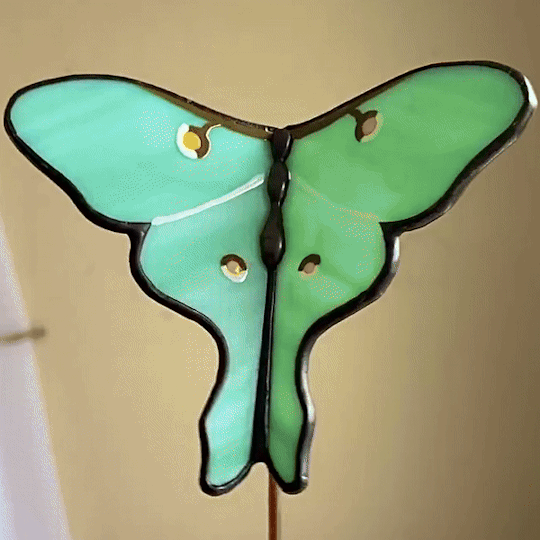
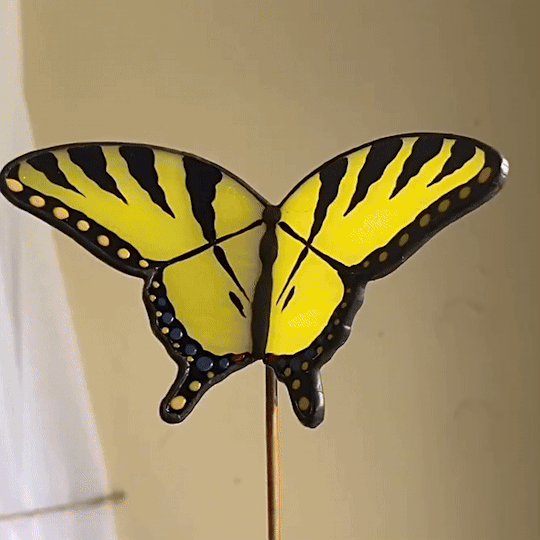

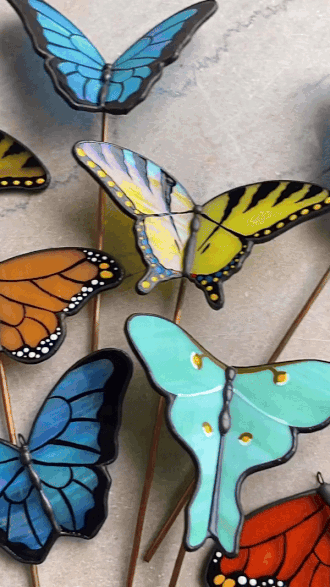

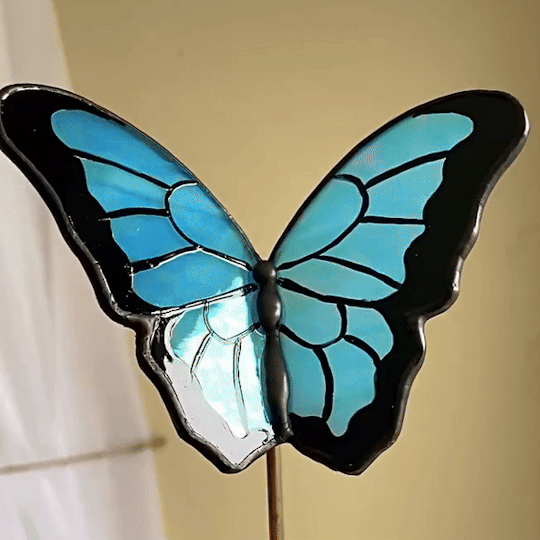
stained glass butterfly & moth plant stakes 🦋 | curiositygarden.ks on ig
#stim#butterflies#decor#stained glass#sfw#green#yellow#black#orange#blue#red#white#fake animals#shiny#plant stakes#handmade art#moths#luna moth#actias luna#eastern tiger swallowtail#papilio glaucus#monarch butterfly#danaus plexippus#common blue morpho#morpho peleides#ii think those are all the real life butterflies and moths these are based on#hands#plants#ishy gifs#postish
562 notes
·
View notes
Text

5 notes
·
View notes
Text
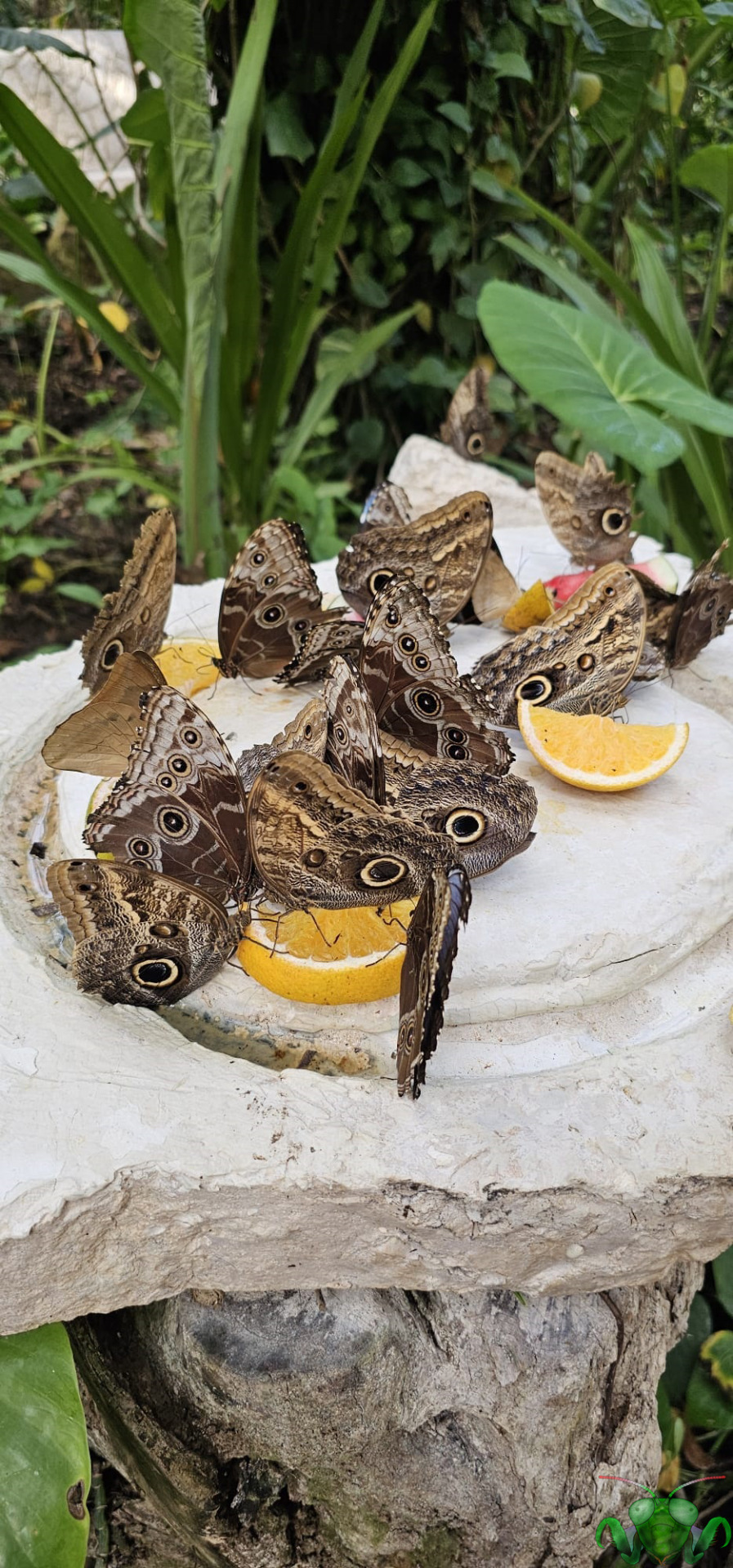





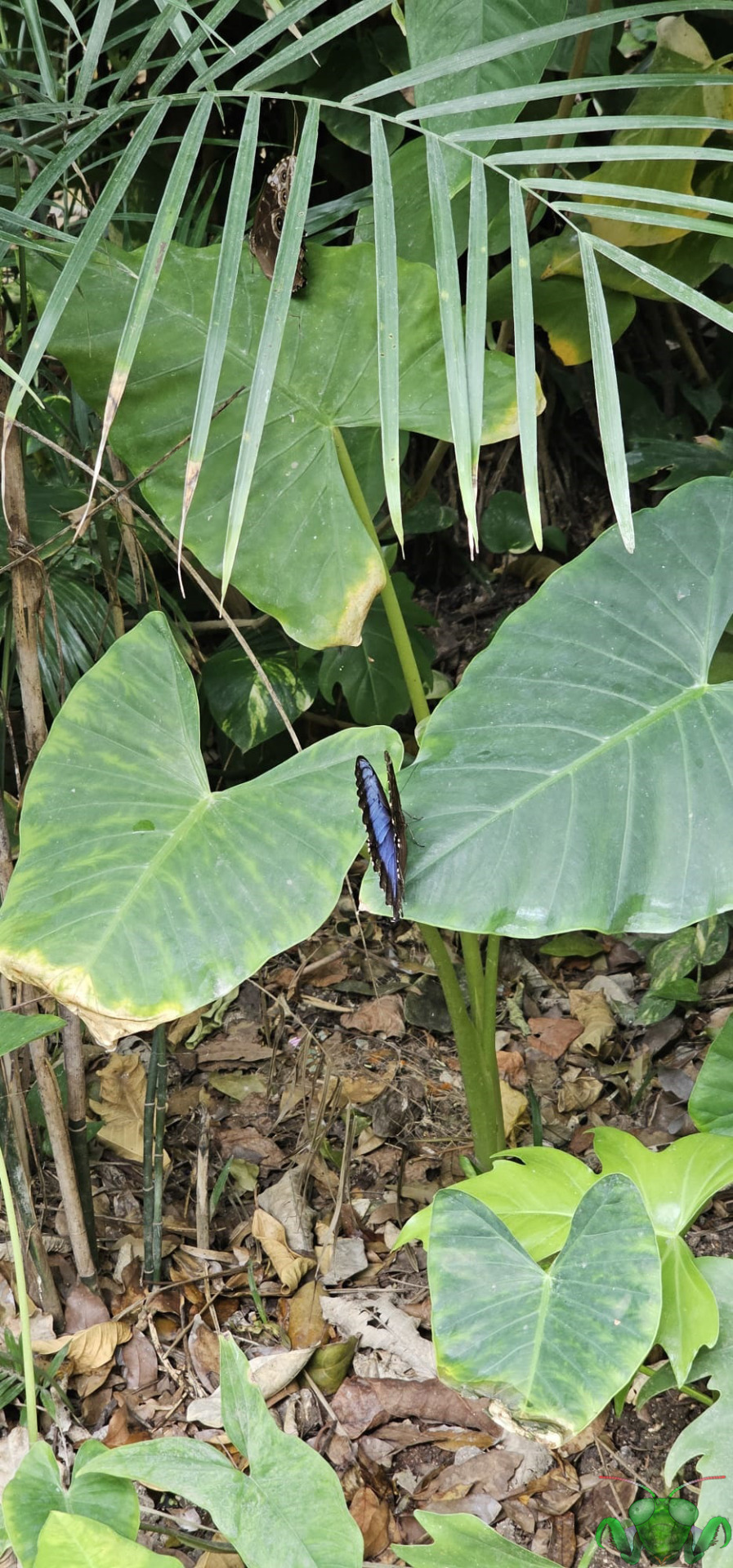

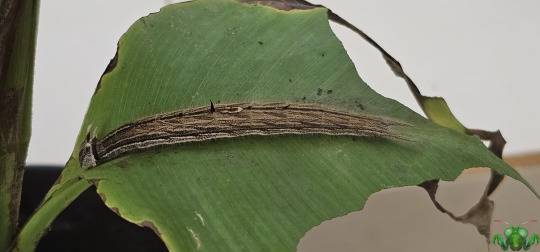
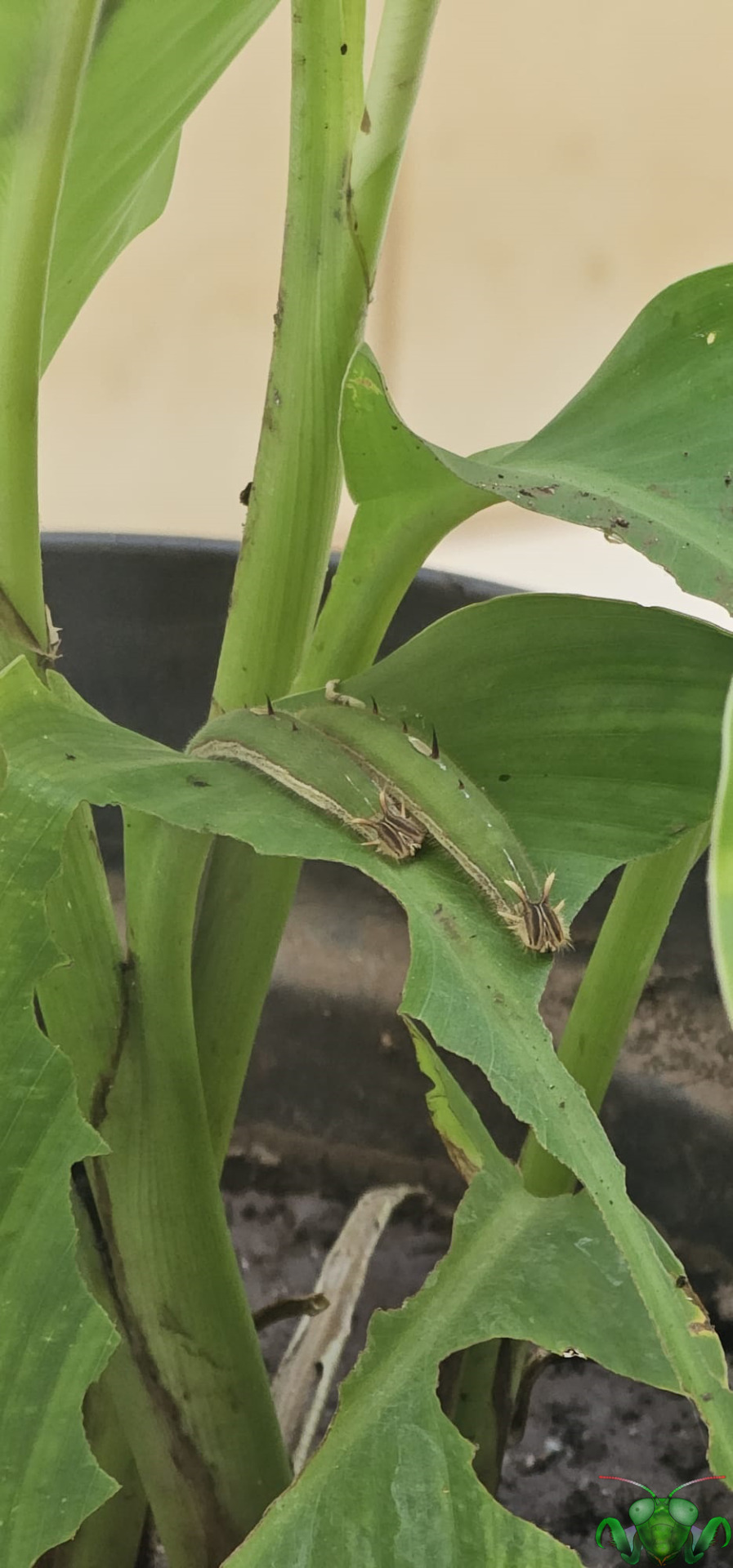
Brush-Footed Butterfly Snack Time & Hungry Owl Caterpillars
Our time observing the Butterflies of Mexico comes to a close with a delight sight of many individuals coming in to land for a citrus-filled snack! In this Butterfly garden, snacks are placed to encourage photography and closer glimpses at these beautiful insects. Handling is discouraged of course, but I'd be willing to bet that these Butterflies wouldn't mind flying over if you were close enough and holding some fruit. Using the orange slices, you can get a sense of scale for these scale-winged insects, and all things considered they are quite large and if they were to open their wings, their wingspan would be impressive! At this snack station, there are (at least) 3 different species of Butterflies congregating and sipping with their proboscises. Though different in many ways, these Brush-Footed Butterflies have one beautiful thing in common: their drab/mottled colored wings conceal vibrant colors on their dorsal side, aiding their survivability via cryptic camouflage. See if you can identify which specie is which.
The most conspicuous of these 3 are the Giant Owl Butterflies (Caligo telamonius), so named because of their large eye-spots on their hindwing's underside. Their cryptic colors combined with their dusk flying allows them to fly around with low risk of bird attack. And if a bird does attack, the eye-spots make a handy decoy. The hypothesis that the eye-spots deter predators by resembling a predators' eyes has been called into question. It's dorsal side features white, blue and black wings.
My dear friend was also able to find some Giant Owl Caterpillars among the plants. With the horn-like structures on their faces, the lines along their body and their spiny protrusions, they remind me of dragons. The wrigglers here appear to be enjoying Musa plants (the leaves appear similar to those of banana trees, one of which my family has had before). The green individuals appear to be the further developed instar since the spines are more prominent and far larger.
The individuals with brown and white wings featuring many ring-patterned spots are actually the Blue Morpho (Morpho peleides), one of the most iconic and iridescent-winged Butterflies. A few individuals here actually showcase their blue dorsal side (see Pictures 2, 3 and 7). Amazingly, their scale color is not caused by pigmentation of the scale, but rather the scale's prismatic qualities (a phenomenon known as structural color) which are stacked, resulting in entering light wavelengths manifesting only the blue wavelength of light.
Finally, try and spot the One-Spotted Preponas (Archaeoprepona demophon). These were the hardest to identify since they blend in amongst their larger friends and their tan-colored wings would make them difficult to see in the wild. What made the difference for me was the curvature along a vein in the hindwing. In comparison to their conspicuous fruit-mates, they aren't so distracting. However, up close there's quite a bit to enjoy. Looking at pictures other photographers have taken, they have a pink proboscis and a stunning teal-blue and black pattern on their dorsal wings.
Pictures were taken on February 11, 2024 in Mexico with a Samsung Galaxy S23 Ultra.
#jonny’s insect catalogue#giant owl butterfly#one spotted prepona butterfly#blue morpho butterfly#giant owl butterfly caterpillar#butterfly#caterpillar#giant owl caterpillar#one spotted prepona#blue morpho#brush footed butterfly#lepidoptera#insect#mexico#february2024#2024#nature#entomology#invertebrates#arthropods#photography#animals
10 notes
·
View notes
Text
Day Twenty-Eight: Moon
I can see this conversation happening...

Isabela finished her last order of the day but was running late. She rushed through the town to a small café and found Bubo was still there waiting for her. He was off in a corner dabbing a paint brush in some water. She sat down, and he looked up from his painting and Isa asked,
“Oh that’s really beautiful. What sort of butterfly is that?”
“A hypolimnas bolina. Its color is rather striking too, these paints don’t do it justice though. It is far more vibrant. Like the blue morphos you said were in your room. Only these are very dark, almost black, so the white spots are very prominent. It boasts a wingspan between 95-105 mm.”
“Bubo, what’s its common name.”
“Sorry, it’s a Blue Moon Butterfly.”
“Oh are they from Colombia?”
“No, they are a more Asiatic butterfly. I just think they’re pretty.”
11 notes
·
View notes
Text
Invertober 2023!
Invertober is back! The (mandatory) drawing challenge where you draw an invertebrate every day. It's for everyone and *mandatory.* Last year they had no ants on the list! I was very upset... this year there is one ant... an improvement, still so much more room to grow!
Let's shoot for 10 ants next year.
OK here is what you need to draw each day for the month:
Sunburst diving beetle (Themanectus marmoratus)
Silvery leaf cutter bee (Megachile leachella)
Little fire ant (Wasmannia auropunctata)
Emerald green snail (Papustyla pulcherrima)
Citrus root weevil (Diaprepes abbreviatus)
Coconut octopus (Amphioctopus marginatus)
Common banded hover fly (Syrphus ribesii)
Calico Crab (Hepatus epheliticus)
Elephant hawk moth (Deilephila elpenor)
Periodical cicada (Magicicada septendecim)
Fruit fly (Drosophila melanogaster)
Eelgrass isopod (Pentidotea resecata)
Devastating grasshopper (Melanoplus devastator)
Blue glaucus (Glaucus atlanticus)
Owlfly (Libelloides macaronius)
Fuchsia flatworm (Pseudoceros ferrugineus)
Blue morpho (Morpho peleides)
Reddish-brown stag beetle (Lucanus capreolus)
White-spotted jellyfish (Phyllorhiza punctata)
European mantis (Mantis religiosa)
Pink crab spider (Thomisus onustus)
Red velvet ant (Dasymutilla occidentalis)
Asian forest scorpion (Heterometrus spinifer)
African monarch (Danaus chrysippus)
Horned sea star (Protoreaster nodosus)
Torpedo bug (Siphanta acuta)
Iceland scallop (Chlamys islandica)
Striped pajama squid (Sepioloidea lineolata)
Tiger centipede (Scolopendra polymorpha)
Leopard slug (Limax maximus)
Halloween pennant (Celithemis eponina)

Let's goooo!
#invertober#invertober2023#drawing#drawings#ants#bugs#bugblr#invertebrates#antblr#drawing ants#artists on tumblr#drawing challange#mandatory#for everyone
11 notes
·
View notes
Text
A peak into the world I've created: The Galaxy!
Zethron is only one of 7 Universes in it's galaxy, not including the center megaverse that they orbit! Each universe has a set "habitat" or biome with set species that we see in each habitat. Each universe will rarely cross with the same kind of species, but it does happen due to the origins of their creation.
There will be another post to define magics, guardians, etc. I promise 🥰
Zethron ~ Woodland Forest
While inhabited by Demons and Angels [2 of 13 Races] which evolved from wolves and doves, it also includes a familiar set of species! Ex. Hedgehog, Rabbit, Lynx, Robin, Fallow Deer, Hawk, Fox, etc.
Magic demons inherit stem from their parent magic- Archaic.
Angels get their magic types from another parent magic- Divine.
Miridian ~ Tundra
This universe is home to another two races -Pantheon and Kitsune-, Pantheons evolved from Arctic Deer and Kitsune from Arctic Fox. Its a cold place so their species sets include the following and more! Ex. Snowy Owl, Polar Bear, Puffin, Caribou, Arctic Hare, Bighorn Sheep, Lemmings, etc.
While Pantheons posses magic similar to that of their parent magic- Cosmic Magic.
Kitsunes have magic that originally started as pure Time Magic.
Rennora ~ Tropical Rainforest
As you can expect, its the most colorful of the universes. It inhabits the Amphithere, derived from Boa Constrictors, and Seraphim, stemming from Blue Morpho Butterflies. The species honor the colorful beauty of the Tropical Rainforests. Ex. Spider Monkey, Capybara, Kinkajou, Two-Toed Sloth, Poison Dart Frog, Tapir, Toucan, etc.
The Guardian of Ampthieres possesses Dimensional Magic, the parent magic to their race.
Meanwhile the Seraphim Guardian has Heartward Magic, passing down other forms to their significant race.
Kotania ~ Under The Sea
A world in the deep seas run by two more races, the Leviathan which evolved from Jellyfish and the Kraken who expectedly came from squid! These scaly set of species are not one to mess with! Ex. Seahore, Vampire Squid, Great White Shark, Dolphin, Orca, Catfish, Yeti Crab, etc.
But not only waterbound ones! Believe it or not there are infinite sandy islands what inhabit tribes of on-land sea creatures too. Ex. Pelican, Seagull, Hermit Crab, and Otter.
However, the Kraken Guardian parents the magic called Power.
The Leviathan Guardian's parent magic is called Elemental.
Veron ~ Desert
In the hot, sandy lands of Veron lies the Pooka, a race that can't be described better than a fuzzy Kangaroo, and the Pegasus which could not come from any other than the Wild Horse. Their species will be exactly what you can expect. Ex. Jackel, Road Runner, Meerkat, Camel, Carcal, Tarantula, Scorpian, etc.
Pooka magic come from their parent magic named Illusion.
While Pegasi have magic stemming from a parent magic called Spirit.
Agape ~ Savannahs
Dry grass and rare trees inhabit two of the last races. One of which is the Pheonix, the final form of what was previously a peacock. And lastly but definitely not leastly, the Ghoul Race, originally known as Vultures. Common species of the grassy landscapes include the following. Ex. African Lion, Ostrich, Zebra, Wild Dog, Giraffe, Elephant, Hippo, etc.
The Ghoul race magic stem from their parent, Sacrificial Magic.
And finally, the Pheonix, probably surprisingly, stem from the veins of Stormforce magic.
Outis - Bad Lands
Ņ̷̨̧̬͇̗̝̘̟͈̤̻͎͕̻̝̙̜̠͍̠̠͉͇̰̜̘̺̖̩͎̲̭̙̣͊͋̇̈͒́̀̇̒͛̈́̇̀́̊̉̏̇̇́̂͋̑̔̀͐̅̃̌̔͊͌̊̄̀̊̉͘͠ơ̷̡̢͔̹̙̦̝̠̊̍̂̇͑̏͊̎̅̅́̈͌͒̀̏̈́͌̓̂̓̈́̌̓̂̐͂͗͐̔̕̕͝ͅ ̵̨͎̱̠͓̝̞͉̣̭̼͍̜̳̮͔͚̺͇̘͕͍̪̭̍̆̂̀̽̒́̀͂͌̂̄̈́͒̅̉̒́̀̀͑́̈́̃̾͘̚͜͜͝ͅͅL̷̠͖̹̱͍̩̽̀́̈́ȯ̶̳̜̘̩̮͖̼͕͍̥̼̼͔͉͓̼̜͑̔͋̀͜͜ͅn̵̢̧̝͎̹̥̟̪̭̠̬̼͔̞̮̘͕̫̜̖̤̼̼̖̞̱̱̹̪̲̘̰̄̍̓́́̀̊͑͐̆̑͌̆͂̃͗͐͐̈̿̋͒̿͐̆͛̈́̀͂̏͘͘͜͝͝͝͝͝͠g̶̢̢̡̗͉͖͓͆̋̒̈̂̅͑̅̀͌̀̈͘̕͘͝͝͝ȩ̸̧̡̛͎͉̖̖̠̤͍̭͕̜̭͕͈̲̺͔͈̼̗̳̰̗͓̬̯̠̜̟̺̬̲̥̼̮̟̮̺̾͛̅͘͜r̸̡̢̛̛͖̭̜͕̟͙̳̞͑̋͂͗̑̒́̈́̈́̈͊́̈͂̔̏̇̎̀̓̉̓̕͠ ̶̢̧̺̭̖͕͖̗̼͗̄́̈͜͠͝A̴͖͉̜̰̮̠̳͔̦̘̟̩͎̅̈̏̓͑͆͛̿̈̽̾̆̑͗̆̕̚͠��̧̧̨̪͙̠͚͚̖̰̞̪̞̥̗̪̰͖͉̻̲̯̰̥͔̼̰̠̯̹̬̰̲̬ͅc̴̨̛̛͉̠̪̙̰͙͇̪̦̰̰̱̝̦̳̞̘̲̖͙̲̻̰̱͈̩̣͙̩̭̣͑͐̆͊̅́̓̽̔̊͊͐̍̓̌͆̃̉̐̓͘͘̚͝͝͝ͅc̶̡̨̛̛̛̛̻̻͔̘̯̯̼̪̙͖̤̹̱͔͇̳̺͓͒̾̈̑͂̃̒̃̋̀̈́̒̉̍̒́̓́͌͗͗͊̿̈̐̊̑̽̈̋͛͜͝ė̵̡̧̧̡̨̧̛̺̲̥̺̺̞̤̥̫̯̻̰̬̯̙͎̙͚̳͈͚̲͙̎̂͑̋̾̇̌̒̉̀́̀̀̈̑́́͊́͛̄̒̉̒͘͝͠͝͝͝s̶̨̢̢̧̨̨͚͉̘̠̻̞͍̼̪̹͉͖̜̮̣̜̗̫̠̗͉̣͍͍͐́̀̊̈̒́̋̿̅̂̈́͛̒͐̊̇͂̔́̿̎̈́̈́͛̆̇͒̄̃͆̕͘̚̚͘͝͝s̸̢̧̢̛̰͇̺̝̭̦̜͓̭̼͉̺̠̼̻̱̞̣̭̭͇̘͍̗̘̱͍̰̯̫͙̀̍̅͂̍́͜ͅi̸̧̞͍̪̦̪̫̹̩͙̺̠̲͔͈̠̓́̔̿̄̑̇̽͗̉̏̉͑̌̽̂́͑̀͊͑͋̑̏̃͌͠͝͠b̴̡̢̧̢̛̛̛̺̼̻̬͍̼̗͔̯͉̼̪̭͔͎̱̩̗̖͔̣̱̭̼͉̟̬̬͓̦̣̤̣̩̤͔͙̟̘̮͆͂̀̒̈́̽̂̿͌̋̒̇͋̊͗̾̍̅͌̓̒̂͘͜͠l̸̡̧̡̛̛̪̫͔̠̼͙̠͇͖̼͙̠̬̙̗̗̬̥͇̦̗̱̬̳̳̫̟̭͉͉̥̹̻̱̥̣̝̾̾͊̊̄̎̊̈̎̏̅̄̈͆́̄̓̌͋́̈́̚͘͜͜͠͠ë̵̯͔̘̺͌͂̀͐́
2 notes
·
View notes
Note
hmmm top 5 bugs?
hmmmmm
#1 has gotta be ladybugs since that's where my interest in bugs first started
#2 - atlas moths
#3 - emerald swallotail butterflies
#4 - blue morpho butterflies
#5 - the humble and common house spider (it's like a friend that eats flies for me)
#my choices feel basic especially cause i have two butterflies on here but i'm a sucker for pretty bugs#asktion
9 notes
·
View notes